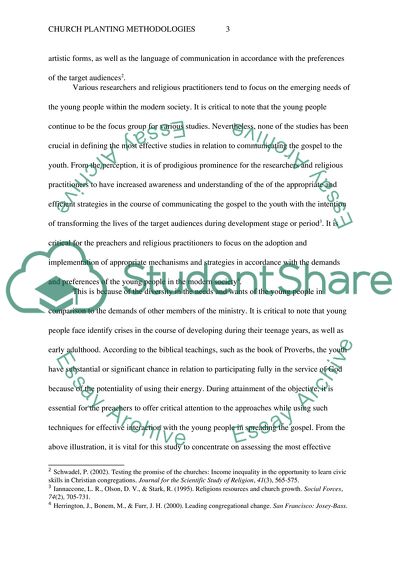Cite this document
(Church Planting by Producing Multiple Congregations Research Paper Example | Topics and Well Written Essays - 5000 words, n.d.)
Church Planting by Producing Multiple Congregations Research Paper Example | Topics and Well Written Essays - 5000 words. https://studentshare.org/religion-and-theology/1877323-identify-analyse-and-evaluate-appropriate-ethnographic-research-methods-and-church-planting-approaches-to-enable-a-potential-church-plant-in-the-community-identified-in-your-proposal-to-understand-their-context
Church Planting by Producing Multiple Congregations Research Paper Example | Topics and Well Written Essays - 5000 words. https://studentshare.org/religion-and-theology/1877323-identify-analyse-and-evaluate-appropriate-ethnographic-research-methods-and-church-planting-approaches-to-enable-a-potential-church-plant-in-the-community-identified-in-your-proposal-to-understand-their-context
(Church Planting by Producing Multiple Congregations Research Paper Example | Topics and Well Written Essays - 5000 Words)
Church Planting by Producing Multiple Congregations Research Paper Example | Topics and Well Written Essays - 5000 Words. https://studentshare.org/religion-and-theology/1877323-identify-analyse-and-evaluate-appropriate-ethnographic-research-methods-and-church-planting-approaches-to-enable-a-potential-church-plant-in-the-community-identified-in-your-proposal-to-understand-their-context.
Church Planting by Producing Multiple Congregations Research Paper Example | Topics and Well Written Essays - 5000 Words. https://studentshare.org/religion-and-theology/1877323-identify-analyse-and-evaluate-appropriate-ethnographic-research-methods-and-church-planting-approaches-to-enable-a-potential-church-plant-in-the-community-identified-in-your-proposal-to-understand-their-context.
“Church Planting by Producing Multiple Congregations Research Paper Example | Topics and Well Written Essays - 5000 Words”. https://studentshare.org/religion-and-theology/1877323-identify-analyse-and-evaluate-appropriate-ethnographic-research-methods-and-church-planting-approaches-to-enable-a-potential-church-plant-in-the-community-identified-in-your-proposal-to-understand-their-context.


